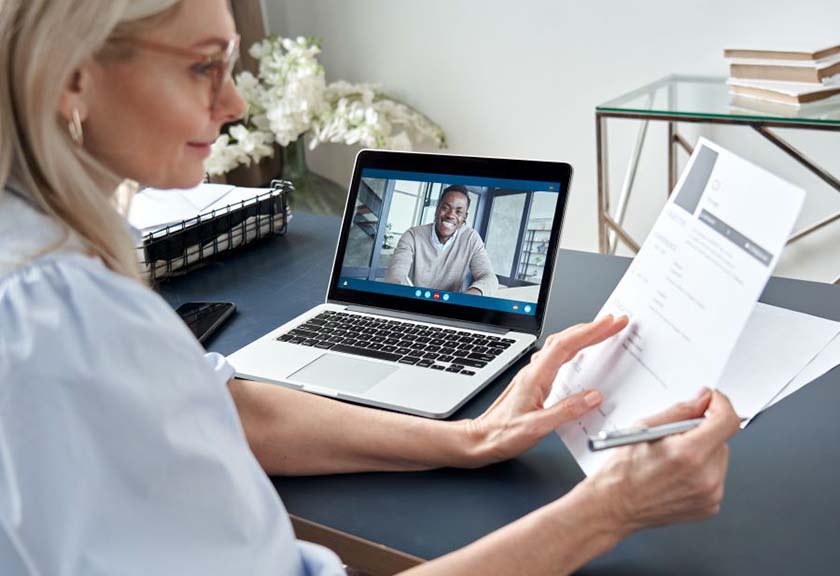Knowing how to interview someone for a job—whether in person, by phone, or via video—will help you discern whether an applicant is a good fit for your open positions. It is a fairly straightforward process that involves gathering the needed documentation, scheduling the interview, sharing information with the candidate, conducting the interview, and then evaluating and following up with the candidate.

Thank you for downloading!
ZipRecruiter can assist you with all your hiring needs – from job postings to interviewing to onboarding.
For a detailed look at the process of interviewing candidates for employment, view our video overview or read through the seven steps below.
Step 1: Gather Position & Candidate-related Documents
Once you are sure you want to interview an applicant for a job, you must gather all the information and documents needed to conduct the interview. That may include a job description, a copy of the candidate’s employment application, and a resume. It might also include a copy of the job ad you posted and perhaps even an organizational chart to see where the job fits within your organization.
If you want to snap up the best talent fast, it’s crucial to set up an interview shortly after the job seeker has applied to the open position. In a tight labor market, top candidates get hired quickly.
The position or job description is a one- to two-page document that describes what the job is about and the minimum requirements of the job. It’s best to share the job description with job seekers before the interview. You’ll also want to go over it with them as a point of reference so you can compare their work history, skills, education, and interests to the job you have available.
Sample Job Description
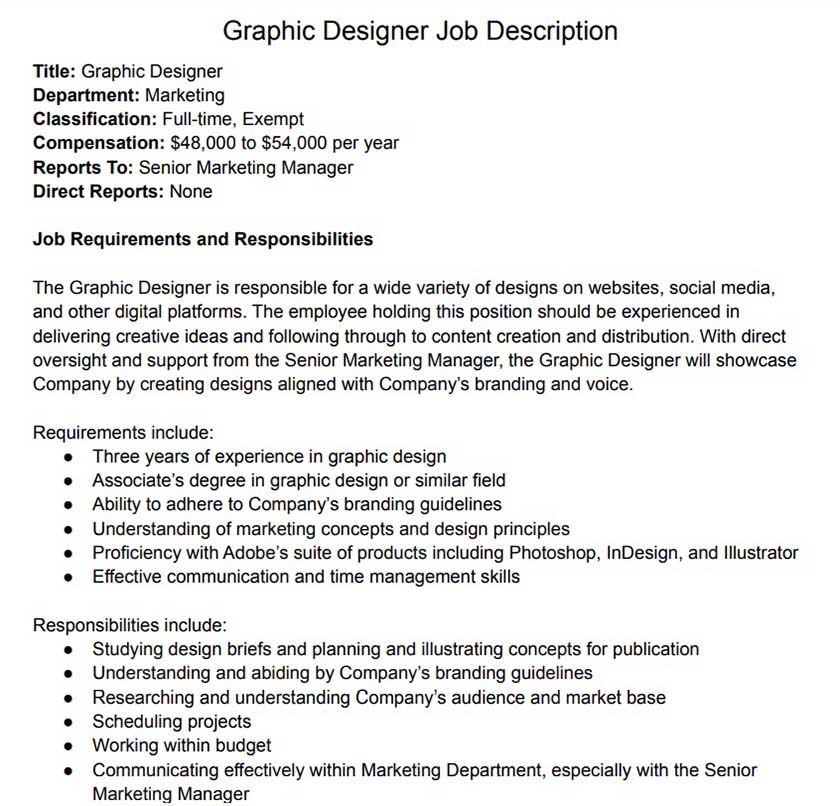
(Source: Fit Small Business)
It’s crucial to read what interview prospects write on their job applications. For example, they may mention working for a competitor, or they may still be in school. It’s helpful to know their background before you start asking them questions in the interview.
When it comes to company job applications, we strongly recommend using them on an as-needed basis. That is to say, many of your best candidates may be passive job seekers (or, people who are currently employed but are seeking other employment). Many passive job seekers will not take time out of their busy lives to complete a lengthy job application. They will submit a resume and, at times, a cover letter, and that’s about it. Do not disqualify these top candidates just because they are not completing your job applications.
Sample Employment Application
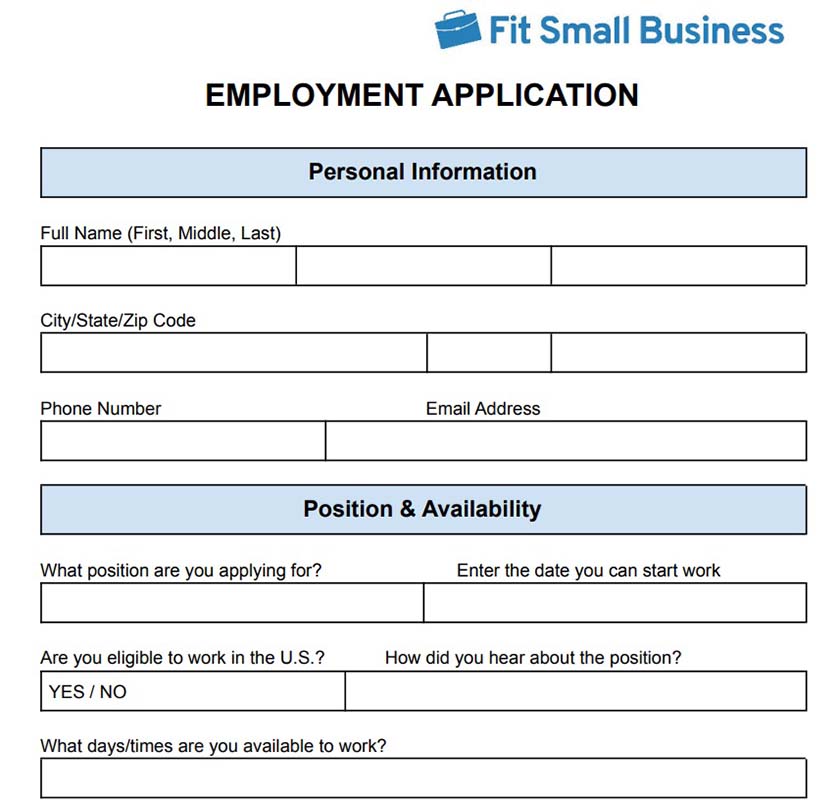
(Source: Fit Small Business)
To ensure your job application forms and job descriptions abide by federal labor and anti-discrimination laws, consider using an all-in-one HR platform designed to streamline and automate the hiring process. We recommend Rippling, our top HR software for small businesses. Besides robust HR functions, it also offers an intuitive applicant tracking system that can help optimize your recruitment process. Visit Rippling to find out more.
Not all job seekers send a resume when they complete a job application form (for instance, you may not need a resume for a hotel maintenance worker). But if they’ve attached or sent a copy of their resume, that document can serve as a foundation for the types of questions to ask during the interview. Imagine if the job seeker had a long lapse between jobs—you may want to understand why.
Job boards, like ZipRecruiter, store resumes online and can even parse them so you can see how well each resume matches the job requirements. Visit ZipRecruiter or check out our article on the best job posting websites to find options that might suit your needs.
Cover letters are more common with professional jobs or online job applications. You’ll often find tidbits about the candidate that you may not have found on their resume. Cover letters are typically more personal and informal, allowing you to get a glimpse of the person’s character, temperament, or work interests.
If you’ve posted a job ad online, it’s useful to have that ad handy so you can ask the job seeker, “What was it about our job ad that inspired you to apply?” Their answer will often give you insight into their work motivation or help you understand what keywords caught their attention as they were searching for work.
Sample Job Ad
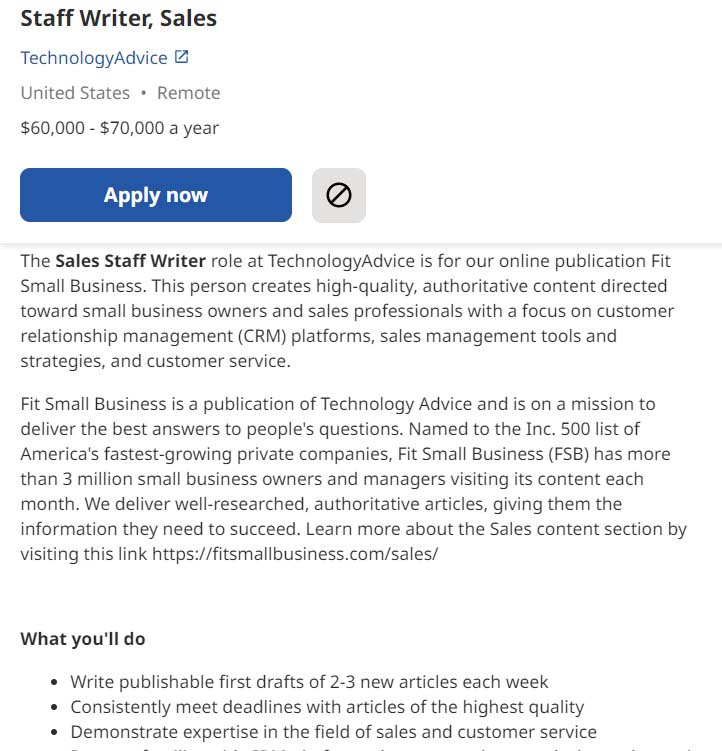
(Source: Indeed)
Having your company organization chart handy before your interview gives you a clear view of where the job role fits. That will help you consider who they will work with and to whom they will report. Knowing their future manager’s personalities and work styles and potential new peers will help you assess the candidate’s ability to fit within the organization and department.
Sample Organization Chart
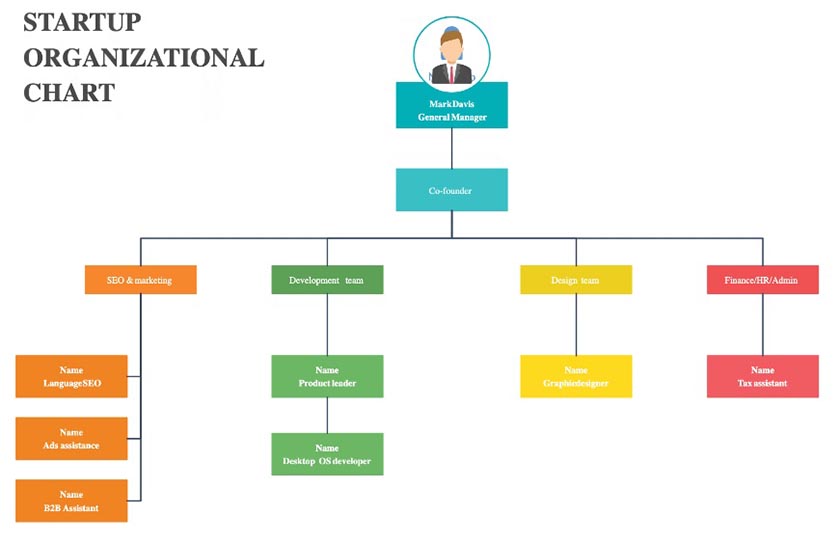
(Source: Creately)
Need an easy way to create an organizational chart? Read our article on the best organizational chart software to find some easy-to-use options.
Step 2: Determine Interview Type & Schedule It
Once you have your information together, you’ll need to decide on the type of interview you want to conduct and then schedule a time.
Types of Job Interviews
There are three commonly used interview approaches when recruiting. A phone interview, an online interview (which can include video or not), and an on-site interview are used most often.
Here’s more on each type of job interview and when to use them:
Did You Know?
Not all interviews are with external candidates. A stay interview is when you speak with current employees about what they like and dislike about their job. Stay interviews seek information on overall job satisfaction and how employees engage within the company and with their colleagues.
Tools for Interview Scheduling
While there are apps to help you sync your calendar with the candidate, a person-to-person conversation is best. Call or text the individual to let them know you wish to interview them. Then follow up with a calendar appointment request, as needed.
Interview Timing & Length
Before you send the interview invitation, you’ll need to figure out how long you want the candidate to be in the office and how much time you want each person to interview them. An hourlong meeting is the most common interview time frame when you’re doing a one-on-one interview.
Depending on what the role is and who the interviewers are, it might be appropriate to:
- Pair up: Have two interviewers work together—for example, two co-owners of a business might interview a candidate for a key position together.
- Go informal: For people-facing roles, an interview in an informal setting, like during lunch or dinner, might be more appropriate—and may take longer than an hour.
- Stay traditional: Schedule one-on-one interviews, back to back.
Let’s look at how you might typically break up an interview for timing based on the kind of role you’re interviewing for and how many interviewers are involved.
Average Interview Time | |||
|---|---|---|---|
Type of Role | 1 Interviewer | 2 Interviewers | 3 or More Interviewers |
Non-Management | 45-60 minutes | 30-45 minutes each | 15-30 minutes each |
Management Role | 60-90 minutes | 45-60 minutes each | 30-45 minutes each |
If your interview is virtual, be sure to block out an appropriate amount of time for the interview. You may want to block 15 minutes prior and 15-30 minutes after the interview in case the candidate shows up early, or the interview runs longer than scheduled.
Questions to Ask Yourself
Interviews may be done by you alone or with the help of a team. In fact, your entire interviewing process requires you to think through how you’re going to assess the candidate in total.
As you’re scheduling interviews, follow these tips for interviewing someone by asking yourself these questions:
- Who is the best person or persons to interview candidates for this job? You might consider someone experienced in the role to assess technical skills, for instance.
- How quickly do you need to hire someone? That may dictate who and how many people interview the candidate, as well as how quickly those interviews are scheduled.
- How will you determine if the candidate is a good fit for your culture? In addition to phone, video, or in-office interviews, you may want to assess a candidate’s interpersonal skills in a social setting, like a group lunch with your team.
- How will you decide on the best candidate? This should be determined based on the candidate’s skills and experience.
Step 3: Share Information With the Candidate
Smart interviewers provide candidates with the information they need to schedule and arrive at the interview prepared and on time. The more information you can share with a candidate, the better.
As the interviewer, do your part to help the candidate succeed during the interview. The goal should be that both the interviewer and the interviewee can focus on the position at hand and not on extenuating circumstances.
Information that you may want to include in your interview invitation:
- Logistics: Include the time, length, and location of the interview, including a Google map link to your offices or link to your virtual meeting.
- People: Describe who they will be meeting and who they should ask for when they arrive. Will this be a one-on-one interview or a panel interview?
- Contact information: Provide the phone number or email account they should use if there is an emergency on the day of the interview and they need to cancel.
- Format: Describe the structure of your interview. Will they be making a mock presentation? Are there specific questions you want them to prepare for in advance?
- Dress code: It’s a nice touch to include dress code information, especially if your office is super casual. This prevents the candidate from overdressing and feeling out of place.
- Location specifics: Anything they might need to know in advance, like if parking is difficult, the office doorbell is broken, or they need a code to get through security.
Step 4: Create Your Interview Guide
An interview guide can be as simple as a piece of paper with a few questions and room to take notes, or it can be an evaluation spreadsheet with specific scenarios and a scoring mechanism. What’s important is that you know in advance what kinds of interview questions to ask and why. It’s also not a bad idea to know which interview questions to avoid, as some may be discriminatory.
- “What do you know about our company?” This tells you a lot about whether the candidate has prepared for the interview and if they have done their due diligence.
- “What keeps you interested in this field? How do you keep current with best practices?” This is good for both experienced and entry-level hires to show you they’re truly interested in the field, passionate about the role, and want to learn.
- “What do you think the position involves doing on a daily basis?” Expectations are an important part of the hiring process. For experienced hires, this tells you what they have done in their previous role; for new grads, it helps you to figure out what they expect and why—and for you to determine whether those expectations are realistic.
- “Now that I’ve told you all about the role and the company, why do you think this is a good fit for you?” This question shows whether the candidate was listening to you and lets them accurately match their skills and talents to the job role.
- “Do you have any questions for me?” This is a good question that helps expose whether or not the candidate has done any research about the position and whether or not the candidate has unanswered questions at the end of the interview.
Keep in mind that federal labor laws restrict the kinds of questions you can ask. In addition, some state laws prohibit asking about or discriminating based on a candidate’s prior salary history, criminal background, or sexual orientation.
The most important aspect of your interview guide is the questions you need to ask to assess the job candidate’s technical and interpersonal skills.
- If it’s a customer service job, are they naturally friendly? How do they handle angry customers?
- If it’s an equipment-operator job, do they have the proper licensing and certifications?
- If the job requires physical strength, like lifting 50-pound boxes, are they able to do that?
A behavioral interview is often the best way to assess a job applicant’s experience. It includes questions about each of the job-related skills needed to be successful and asks the candidate to tell about a time when, for example:
- They overcame a client objection
- They organized and completed a large complex project
- They trained a team to learn new software
- They found and resolved a safety issue
- They said “no” to their manager and why
Another consideration for your job interview is to identify a real-life, work-related project or task you could assign to the candidate during or after the interview. A sample assignment is a great way to learn how your job seeker tackles a task and how well they can complete it.
Examples of sample work assignments might include:
- Translate a customer welcome letter into Spanish.
- Identify three menu items you’d recommend to a diner who can’t eat gluten.
- Tell me the name of each of the plumbing tools on the desk—and how they’re used.
- Suggest three keywords your business might purchase to optimize website performance.
- Create a one-page flyer to promote a new financial product offering.
Another option is to use assessment tools that measure technical skills, personality, trustworthiness, and any number of other skills, such as the ability to use software like Excel. These tools can prevent you from hiring someone who looks good on paper and sounds great in the interview, but ultimately can’t do the job.
Step 5: Conduct the Interview
You have a few options when conducting a job interview. As mentioned above, you can do it one-on-one with the applicant or have a few people participate in a group interview with the job seeker. Often, the first interview is best done one-on-one, as it’s less intimidating for the candidate. It also requires less time from others whom you might want to save for interviewing your final candidates only.
Regardless, here are some do’s and don’ts on how to interview a candidate:
| Interview Do’s: | Interview Don’ts: |
|---|---|
| Set the stage: Create a welcoming environment to put the candidate at ease by introducing yourself and all interviewers. | Display bias: Avoid asking questions unrelated to the job itself. And never scribble notes like wedding rings (married?), a stick figure family (kids?), or anything with racial implications. In a lawsuit, these would be seen as an indication of discrimination. |
| Reiterate the process: Remind your candidate of how your interview process works (e.g., kinds of questions you’ll ask, any tests or assignments you’ll request, and multiple rounds of interviews). | Interrogate: Don’t pepper the candidate with questions to see how they do under stress. That undermines your hiring process; they might assume you and your team are difficult to work with. |
| Pace the interview: Take a deep breath, relax, and get to know the candidate. Allow the candidate time to respond; don’t be afraid of silence. | Ask for free work: If you ask for an assignment to be completed, prepare to pay the candidate for their time. Don’t let your employer brand be undermined by bad online reviews when the job seeker reports that your firm is a scam to get the candidates to do “free work.” |
| Observe: Pay attention to the candidate’s body language as well as their answers. | Go silent: Don’t simply stare at the candidate as you read off your interview questions. Instead, engage in a friendly two-way dialog as you would with a friend. |
| Summarize: Clarify what the next step is (e.g., another interview, an email, or a sample task). | Leave them in the dark: If you’re still interviewing other candidates, let them know. |
| Offer thanks: Thank the candidates for their time, expressing appreciation for their interest in your company and the job role. | Burn bridges: Even if the candidate is a poor fit for the job, treat them with respect. |
Step 6: Write & Compile Your Notes After the Interview
While you will likely take some notes during the interview, the interview is a time to get to know the candidate and interact with eye contact. Save the majority of your notes for after the interview.
An interview evaluation form is an excellent way to capture interview feedback because it helps you document how the candidate responded to different questions throughout the interview. That lets you rate and rank candidates in an unbiased way and select the best candidate for the job instead of the first, last, or most animated person you talked with.
If you prefer digital methods, try an applicant tracking system (ATS), such as ZipRecruiter, that allows you to score interviews, delegate tasks to other hiring team members, and easily follow up with both high- and low-quality candidates.
Step 7: Follow Up With the Job Candidate
Every interaction you have with a job applicant reflects your company brand, and therefore, it’s crucial to follow up with job seekers. The more personalized your response, the better. For example, if the rejected candidate is your second choice and your first choice had significantly more accounting experience, it’s OK to express that you liked them but chose the more experienced person.
It’s helpful to explain what you liked best about the candidate’s skills and experience—and then, wish them well in their job hunt. It may not start as a letter at all—it may be a phone call or email you send to offer the candidate the job.
Job Offer Letter
The offer letter is the communication you send to your top-choice candidate. It typically includes a start date, salary range, and benefits information, as well as a little bit about your company and culture (to entice the job seeker to say “yes”). You may choose to initially offer the job to your top candidate via phone or video call, but, ultimately, to seal the deal, it’s best to document your job offer in writing.
Rejection Letter
The rejection letter is equally important and maybe even more so if you want to maintain a good employment brand. The purpose of the rejection letter is to inform job seekers that you’ve chosen another candidate. It’s also used to thank them for applying and leave the door open for them to reapply for other positions that may come up in the future.
On occasion, you may need to rescind an offer previously made to a candidate. This can happen if the candidate does not pass a background check or drug test, or has inaccurately portrayed their ability to handle the job on their resume.
Need help ironing out your hiring process? Read our in-depth guide on how to hire employees for a structured process.
How to Interview Someone Frequently Asked Questions (FAQs)
If you have never interviewed someone for a job, your first step should be to create a checklist (see our free template above) that outlines what to do before, during, and after the interview. Also, be sure to have your interview questions written ahead of time—this will ensure you ask all necessary questions during the interview.
The questions you ask a candidate during an interview should be job-skill related. This will help you determine if the candidate has the skills and experience necessary to succeed in the open position. Job-skill questions may include:
- Can you walk me through your resume and explain how your background and skills make you the ideal candidate for this position?
- Tell me about a time you had to complete a difficult project. How did you prioritize your tasks, and what was the outcome?
- What do you consider the most important skills someone needs to be successful in this role?
Bottom Line
Conducting an effective interview takes planning and practice. An interview is little more than a structured conversation that helps you evaluate which candidate is the best for your open role. It should be based on the job description and focus on job-related skills and experience. It can also help you learn about the candidate so that you can see whether their work style and values mesh with what’s needed in your business.

